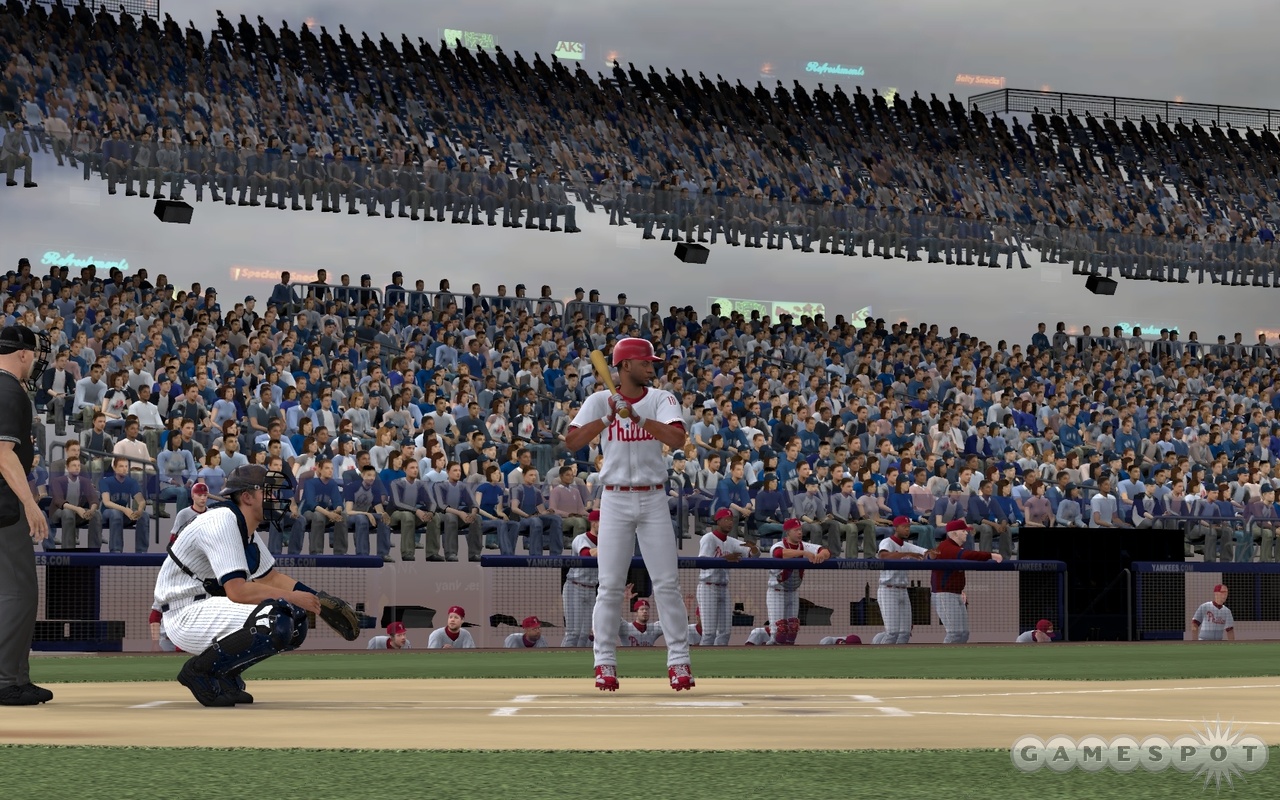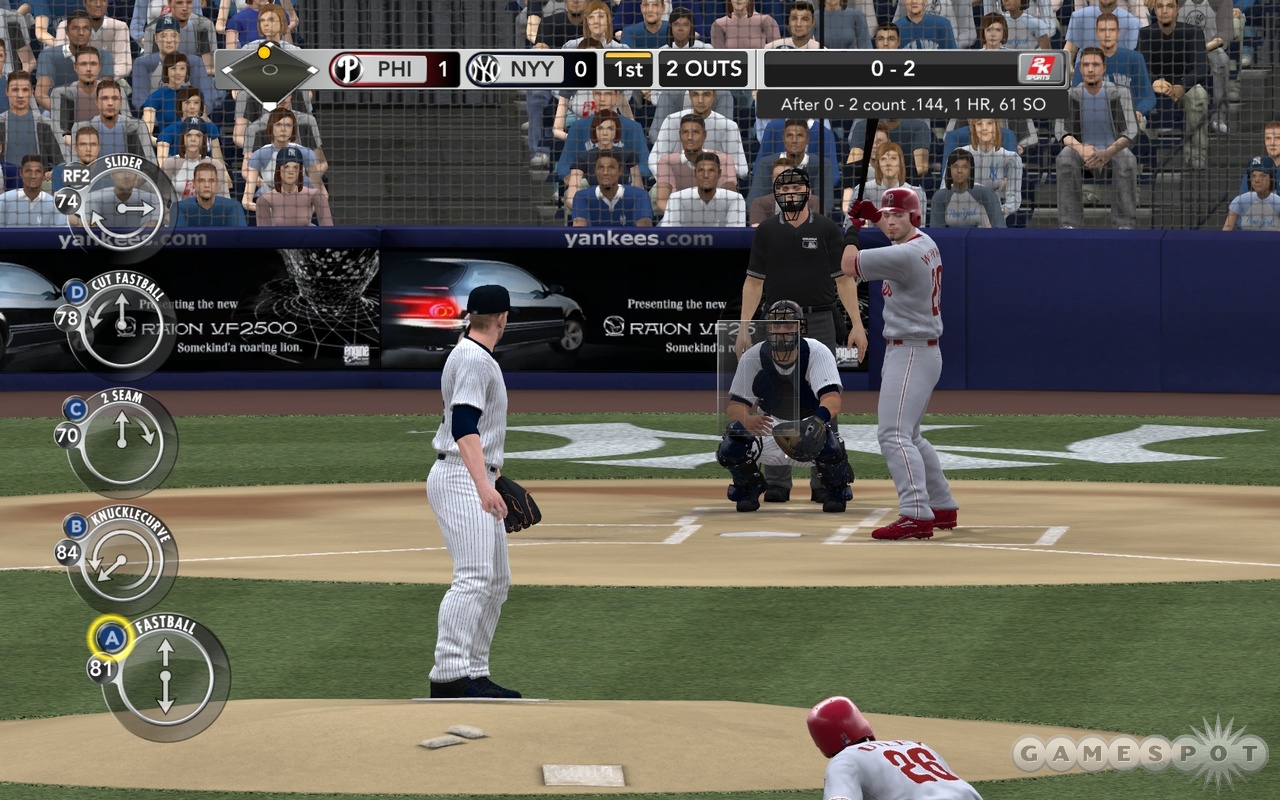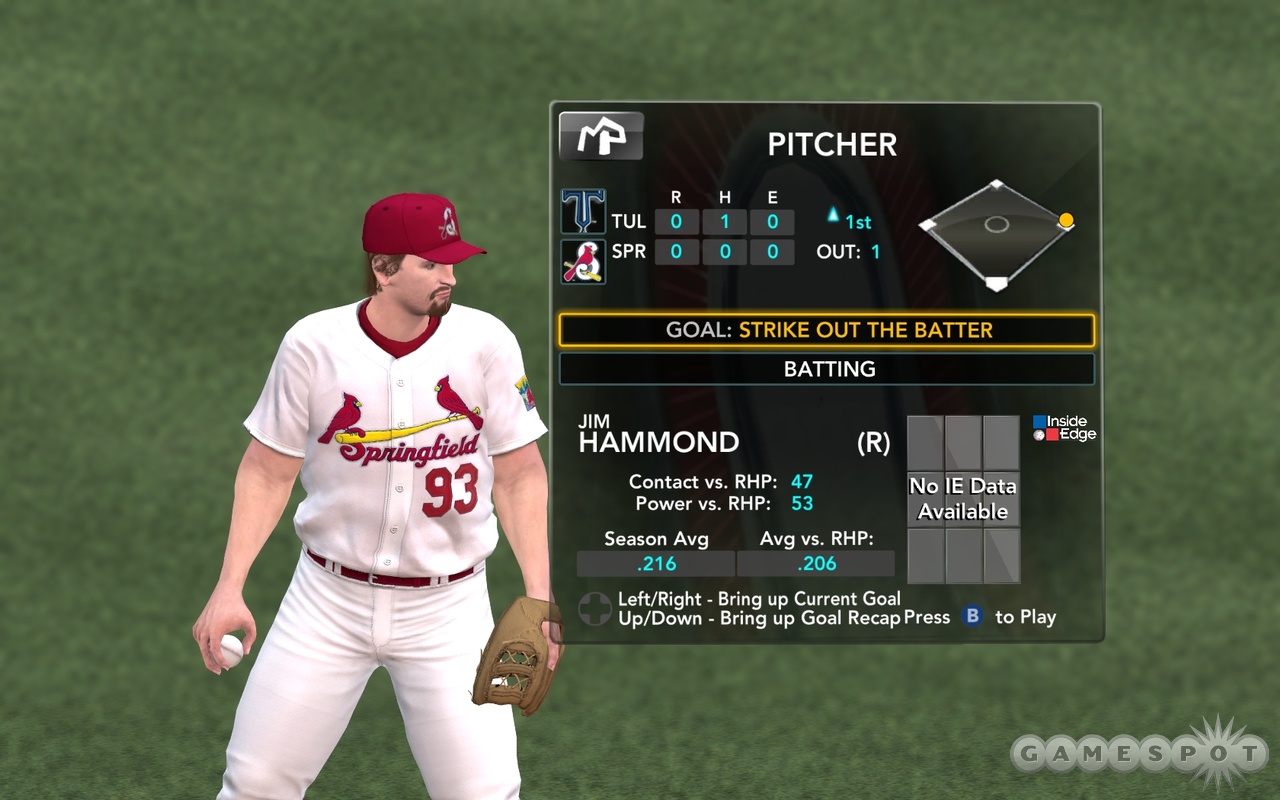If you can't beat 'em, join 'em. Somebody must have scribbled that cheesy old catchphrase on the wall at Visual Concepts sometime in the past year, because the developer has made Major League Baseball 2K10 look and feel a lot like recent entries in the Sony-only MLB: The Show series. Ripping off the competition seems to have been a great idea, too. The result of this copycat-itis is the most fully featured and realistic entry in the decade-long history of 2K Sports' baseball franchise. Gameplay isn't as clean as it could be, especially in the new My Player career option that lets you guide a rookie from the minors to the majors and with some wide-ranging glitches that make the PC port a much more troublesome game than its Xbox 360 and PlayStation 3 cousins. Still, this remains a passable re-creation of the national pastime that--bugs aside--stands head, shoulders, and batting helmet above its predecessors.

Where MLB 2K10 most resembles its crosstown rival The Show is in the addition of My Player mode, an option that lets you create a rookie and take him to the bright lights and big cities of the Major Leagues. You create a rookie phenom, pick a fave franchise to be drafted into, and then set off to try to become an MLB legend. Skill points are awarded just about every time you slip into your spikes. Hit a single, and you get points for hitting. Make a putout or record an assist, and you get points for fielding. Cross home plate with a run, and you get points for baserunning. Strike out the side, and you get points for pitching. And so on. Special objectives and clutch situations provide additional points. You might be called upon to record an out in under five pitches, for example, or work a hit-and-run when standing on first. You take part only in the plays that your player is involved in, which allows you to zip through entire seasons while manually playing nearly every game on the schedule.
How much action you see depends on the position you choose, of course. If you play a pitcher, you're right in there with every toss from the mound, and you can even get called up to the majors after making a measly five starts in AA. If you assume the role of a third baseman, you just take your at-bats and step into the field every now and then to snag liners or catch pop-ups at the hot corner. So it can be a little dull playing a position player, unless you're totally committed. Still, the role-playing aspect is superb, and you'll find yourself feeling a real team vibe, cheering for your buddies when they're at the plate while you're on base, and being satisfied however you contribute to a win. You know you're in a special baseball place when you get a thrill just laying down a bunt to move a runner into scoring position.
Addictive doesn't even begin to describe how compelling My Player can be. Getting hooked is unavoidable if you're any sort of a baseball fan. Games unfold as though you're recording turns in an RPG or a strategy game, so you find yourself stuck playing just one more over and over again as the time flies by. Trying to get your Cooperstown wannabe buffed with the skill points and striving for his success at the plate, in the field, or on the rubber becomes a total compulsion. You can see yourself getting better with every game, improving both manually as you become more adept with the controls and automatically as your skills improve.

That said, My Player is a grind at first for non-pitchers. This is a freshman effort that needs some tweaking. Player progression for anybody who doesn't spend half of a game playing with a rosin bag is tedious. Criteria for being called up to the big leagues is set in stone, so you need to hit targets for things like average, slugging percentage, and games started, as well as reach plateaus in skill ratings such as contact hitting and speed on the basepaths. This presents a problem, because these standards don't account for what sort of player you're trying to build. There is a serious issue with how skill points are awarded to position players for baserunning. For example, to get that phone call from your favorite GM, you need to clock a speed rating of 65, which is all fine and dandy, because Major Leaguers need to move better than the average couch potato. But what if you want to create a lumbering power hitter who might swipe a dozen bases in his career? It's also tough to earn running points no matter what kind of player you're trying to build. Skill points for running are handed out only for things like successfully taking second on hit-and-run plays called by the computer or crossing home plate, all of which is random. It can take a couple of minor league seasons to get up to speed with your running skills, even if you're trying to develop a lead-off Rickey Henderson type.
Another potential issue with My Player is the starting ratings for hitters when it comes to contact and power. Getting good wood on the ball and muscling it into the outfield is not easy during the first two or three years of your career. Rookies are woeful, even for AA ball, with very little pop. You need to time a swing just about perfectly to hit the ball with some authority, and even then your efforts are typically wimpy dribblers that barely make it to an outfielder before dying. If anything, you feel like you're overmatched in the minors, not some future phenom everybody is talking about. Skilled twitch gamers might not have a gripe here. But players who aren't as talented will find themselves either dropping down to rookie difficulty or tweaking the slider settings that determine things like hit power and contact on the default pro difficulty to allow for more oomph at the plate. Neither is a great option, however. Rookie jacks up offense to near-stupid levels (if you don't hit .750 here, check your pulse), and dialing down pro shuts off the ability to unlock player cards in games. It would be great to see this issue addressed with a patch that adjusts the initial hitting contact and power ratings in pro. Even a slight boost to power would make things a lot better.
Other aspects of MLB 2K10 are more traditional, yet still greatly improved over last year's edition of the game. The primary modes of play, such as Franchise, Play Now, Home-Run Derby, online ranked matches, and online league play, return largely unchanged. The only significant addition is the MLB Today option that lets you play through the real 2010 Major League season as it takes place, starting with Grapefruit League action. Both the visuals and audio have been thoroughly overhauled, which is most notable on the PC. This is easily the best-looking version of the game. All of the fine details seen on the consoles, such as the scruffy wannabe beard sported by Roy Halladay, are given extra sharpness here with increased resolution and the ability to use advanced antialiasing settings to smooth out jaggies. But with that said, there are some visual glitches. Hallucinogenic colors and strobe-light flashing is a regular occurrence on start-up that can only be cleared by exiting the game. Odd graphical effects are also common, from wild shaking when batters approach the plate to serious strangeness like transparent stadiums that make it look like fans are sitting midair.

Audio is also something of a mess. Stadium sound effects go in and out, taking you from dead silence and a few yells to nothing but the cheers and jeers of a few yahoos in the stands. It's kind of spooky because you know you should be hearing the roar of thousands of fans. At least this problem doesn't seem to affect the delivery of the broadcast-booth trio Gary Thorne, Steve Phillips, and John Kruk. They offer insights into the games being played, as well as baseball as a whole. They also list stats like Bill James and even call created players by name if you've got a moniker reasonably common in North America. The soundtrack, however, is all over the place and annoying. Does anyone enjoy hearing Pearl Jam and the Sugarhill Gang back-to-back?
Much more attention has been paid to realism this year, which shows up in a vastly enhanced pitcher-hitter duel…if you can get to it. At-bats are more organic now, whether you're on the rubber or in the batter's box. Everything has been dialed back offensively to make things more realistic than the slugfests that characterized previous games in the series, but the PC version of the game has issues with gamepads. Three different pads from Microsoft, Saitek, and Philips were tried, but none functioned properly. All were acknowledged within the control settings, right down to their proper names and button layouts, but each had different issues. Some worked reasonably well during games but refused to work at all during drills. Some worked with some menus but not others, causing problems when you try to access key screens like the ones where you assign skill points in My Player. And all needed to be tweaked in the control configuration menu. This is a widespread problem, and an unfortunate one given that using the keyboard is a much less enjoyable experience. The right-stick pitching interface where you twirl the stick circularly to mimic motions for individual pitch types is clunky and annoying when mapped over to the number pad on a keyboard. You also lose the great pitcher-pressure features where the pad rumbles whenever you get into a tough spot against a big hitter or with runners on base. And guiding runners along the basepaths while taking cuts in the box is about as confusing as flying in a flight simulator, with your hands roaming all over the keyboard.
A few aspects of gameplay feel off whether you're using a gamepad or not. At the default slider settings, everything in the field is too zippy and frantic when you're out there, which comes as a shock when contrasted with the stoic duel between pitchers and batters. Speed isn't so extreme that you can't make plays, but ball and player movements have been accelerated so that catches and throws often look unrealistic. Weird animations make this effect worse. Players often catch pops contorted like they're doing yoga, and first basemen casually take throws flipping down their gloves instead of stretching properly for the ball. Strange movements take place at the end of innings. If you make an inning-ending catch at third, for example, you often start trotting into right field or do a roundabout jog that looks like an unenthusiastic victory lap. Baserunning is probably the most serious issue. It's just about impossible to steal a base with anyone but the best speedsters in the majors. You have to get off to a perfect jump. Go a split-second early, and you get picked off. Go a split-second late, and you're gunned down by a throw that always seems to be dead on and finished off with a flawless tag. It's immensely frustrating, particularly when you're doing baserunning drills early on with a My Player prospect.

Other problems afflict the online multiplayer modes of play on the PC. It's nigh impossible to get hooked up with a random quick match. The game eternally gets stuck in the creating and finding match stages. It will eventually dump you back to the choose-teams screen, saying that a compatible game cannot be found. Trying to arrange a custom game is every bit as frustrating because while you can see how many other players are online, you can't actually identify or connect with them. It's entirely possible that you might be able to get into PC games online, but after numerous attempts and after trying suggestions from 2K tech support, we've still been unable to do so.
Even though MLB 2K10 is a very good baseball game at its heart and is light years beyond the mess that was MLB 2K9, bugs on the PC version keep it from knocking the ball out of the park. You need to either deal with the headaches or ignore them. Neither choice is a particularly good one, but because this is the only game in town when it comes to arcade baseball on the PC, you have to either like it or lump it in this case.